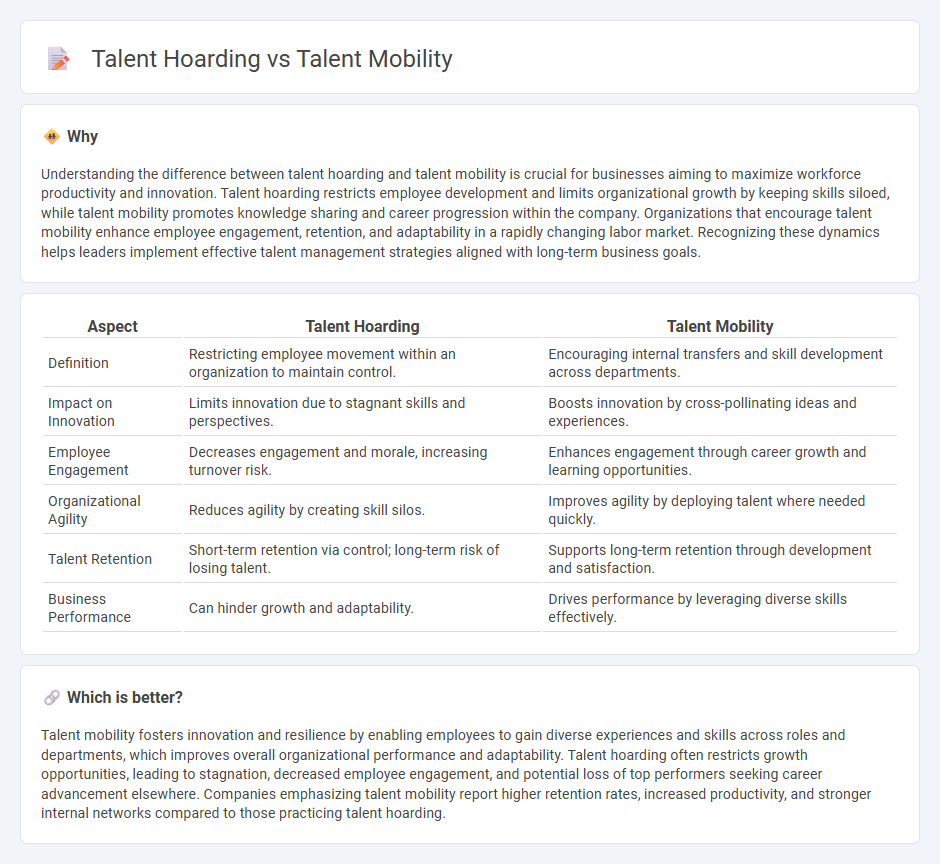
Talent hoarding restricts workforce agility by limiting employee movement within or between organizations, hindering innovation and career growth. Talent mobility enhances organizational adaptability by facilitating skill development, knowledge sharing, and employee retention through internal transfers or external opportunities. Explore strategies to balance talent hoarding and mobility for a competitive employment advantage.
Why it is important
Understanding the difference between talent hoarding and talent mobility is crucial for businesses aiming to maximize workforce productivity and innovation. Talent hoarding restricts employee development and limits organizational growth by keeping skills siloed, while talent mobility promotes knowledge sharing and career progression within the company. Organizations that encourage talent mobility enhance employee engagement, retention, and adaptability in a rapidly changing labor market. Recognizing these dynamics helps leaders implement effective talent management strategies aligned with long-term business goals.
Comparison Table
| Aspect | Talent Hoarding | Talent Mobility |
|---|---|---|
| Definition | Restricting employee movement within an organization to maintain control. | Encouraging internal transfers and skill development across departments. |
| Impact on Innovation | Limits innovation due to stagnant skills and perspectives. | Boosts innovation by cross-pollinating ideas and experiences. |
| Employee Engagement | Decreases engagement and morale, increasing turnover risk. | Enhances engagement through career growth and learning opportunities. |
| Organizational Agility | Reduces agility by creating skill silos. | Improves agility by deploying talent where needed quickly. |
| Talent Retention | Short-term retention via control; long-term risk of losing talent. | Supports long-term retention through development and satisfaction. |
| Business Performance | Can hinder growth and adaptability. | Drives performance by leveraging diverse skills effectively. |
Which is better?
Talent mobility fosters innovation and resilience by enabling employees to gain diverse experiences and skills across roles and departments, which improves overall organizational performance and adaptability. Talent hoarding often restricts growth opportunities, leading to stagnation, decreased employee engagement, and potential loss of top performers seeking career advancement elsewhere. Companies emphasizing talent mobility report higher retention rates, increased productivity, and stronger internal networks compared to those practicing talent hoarding.
Connection
Talent hoarding limits workforce flexibility by restricting employee movement within or between organizations, which reduces overall talent mobility. High levels of talent hoarding create skill bottlenecks, preventing optimal allocation of human capital and impairing organizational agility. Enhancing talent mobility through internal transfers, job rotations, and external opportunities supports knowledge sharing and drives innovation.
Key Terms
Internal Mobility
Talent mobility within organizations drives workforce agility by enabling employees to shift roles and develop new skills, facilitating internal career growth and knowledge transfer. Talent hoarding, conversely, restricts this flow by managers holding onto high performers, which impedes innovation and reduces overall organizational efficiency. Explore in-depth strategies to enhance internal mobility and overcome talent hoarding challenges for sustained business success.
Succession Planning
Talent mobility enhances succession planning by enabling organizations to strategically deploy and develop employees across roles, fostering leadership continuity and agility. Talent hoarding, conversely, stifles growth and limits the talent pipeline, creating bottlenecks and risking critical skill gaps. Explore how effective talent mobility drives robust succession strategies and business success.
Workforce Agility
Talent mobility enhances workforce agility by enabling employees to acquire diverse skills and adapt to evolving business needs, thereby driving innovation and growth. Talent hoarding, conversely, restricts internal movement, stifles knowledge sharing, and limits organizational responsiveness to market changes. Discover strategies to foster talent mobility and boost workforce agility for a competitive advantage.
Source and External Links
What Is Talent Mobility and How does it Benefit Companies - Talent mobility refers to the movement of employees within an organization--such as promotions, lateral shifts, and cross-functional projects--enabling dynamic workforce development and improved retention by offering clear internal career paths.
Talent Mobility - WERC - Talent mobility is a strategic approach ensuring the right people with the right skills are in the right place at the right time, encompassing job rotations, transfers, international assignments, cross-functional moves, and remote work to help companies stay competitive and develop employees.
What Is Internal Mobility and Why Is It Important? - Internal mobility, also known as talent mobility, is the movement of employees to new roles within an organization, serving as a crucial retention and development strategy that prevents talent loss due to lack of growth opportunities.
 dowidth.com
dowidth.com